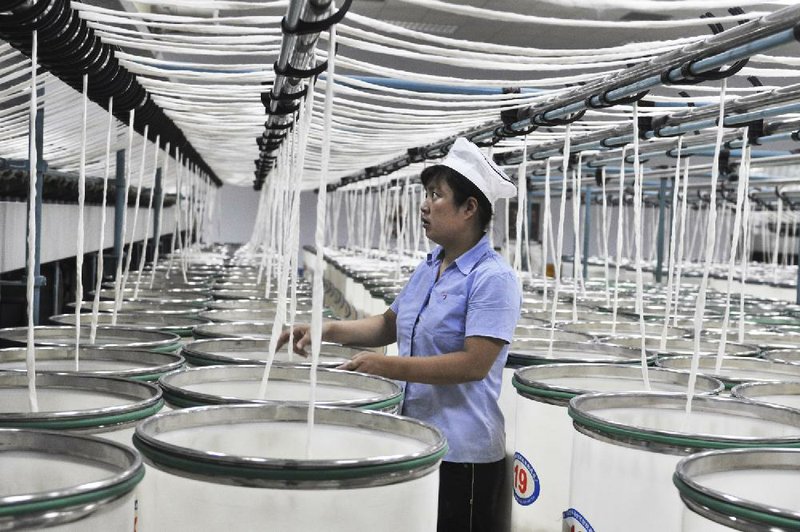BEIJING - A cash shortage hit China’s credit markets this month, and analysts say it was the first shock wave from what stands to be the government’s most drastic clampdown on credit in two decades.
The central bank has called for tighter lending standards, which should reduce risk but are likely to also reduce financing for a private sector that generates China’s new jobs and wealth.
China will benefit in the long run from a safer financial system, analysts say, but the short-term cost could bea painful squeeze on entrepreneurs. Some say a recovery that already was faltering could weaken further.
“It’s going to be a bloodbath,” said Anne Stevenson-Yang, research director of J Capital Research in Beijing.
“Rates are shooting up in the private market and regular commercial loans are being pulled back very quickly,” she said. “All industrial businesses here run on credit, so as soon as you close that down, they just stop producing and selling stuff.”
The government has yet to say how extensive the controls will be or what it might do to ensure lendingfor producers whom Chinese leaders have said they want to support.
Some branches of two of China’s biggest lenders - Bank of China and Industrial and Commercial Bank of China - have temporarily suspended lending to businesses and individuals, the business magazine Caixin reported, citing sources at the banks.
The credit clampdown hits amid uncertainty about whether China’s lackluster recovery from its deepest downturn since the 2008 global crisis is stalling.
Economic growth slowedto 7.7 percent in the first quarter from 7.9 percent the previous quarter.
May retail sales fell short of forecasts and export growth also slowed. An HSBC Corp. survey of manufacturers showed June activity fell to a nine-month low and was contracting.
Harder times for Chinese entrepreneurs could have global repercussions. China’s slowdown already is depressing demand for iron ore, copper and other commodities, crimping the flood of money that drove a boom for Australia, Brazil and other suppliers. Demand for industrial components from Southeast Asia and factory equipment from the United States and Europe could be hurt if credit-starved manufacturers put off purchases.
The crackdown is part of a broader effort by Communist leaders to shift China to slower, more sustainable growth based on domestic consumption after a decade of expansion driven by exports, investment and cheap credit. The ruling party’s growth target this year is 7.5 percent, down by almost half from 2007’s 14.2 percent.
“The episode is arguably the strongest sign yet that the leadership is willing to suffer shortterm economic pain if necessary to achieve more sustainable growth,” said Capital Economics analyst Mark Williams in a report.
A key goal appears to be to force banks to reduce their role in channeling money into unregulated, profitable and risky underground lending that is a pillar of support for entrepreneurs who cannot get formal loans from state banks.
Money for informal lending came at first from individuals who wanted a better return on their savings, but much of it now comes from state banks. They hid the lending from regulators, who worry they have taken on undisclosed risks in the event of defaults.
Even before the credit squeeze, underground borrowers paid interest of up to 70 percent a year - more than 10 times the benchmark rate for formal loans. Estimates of outstanding loans run as high as $650 billion, or as much as 7 percent of China’s total credit.
Communist leaders allowed informal lending to grow over the past decade to support entrepreneurs.
But regulators began to worry after the 2008 global crisis when they found banks were putting their own money into informal lending, taking on unreported higher risks.
Money flowed to entrepreneurs to pay for equipment and raw materials, but it also flooded into speculation in stocks and real estate. Regulators ordered banks to tighten lending standards but worried credit still was growing too fast.
The squeeze on China’s credit markets hit after banks that quickly expanded lendingthis year tried to replenish their resources by borrowing from institutions that had more cash.
Analysts say bankers expected the People’s Bank of China to inject extra money into that interbank market. But the central bank refused to play lender of last resort, causing a credit shortage.
Interest paid by banks for an overnight loan spiked from the normal 2 percent to 3 percent to a record 13.4 percent.
That ignited fears China might face a credit crisis and caused stock prices to tumble.
Some analysts said the central bank is partly to blame because it failed to make clear how tough its stance would be.
Business, Pages 25 on 06/29/2013

